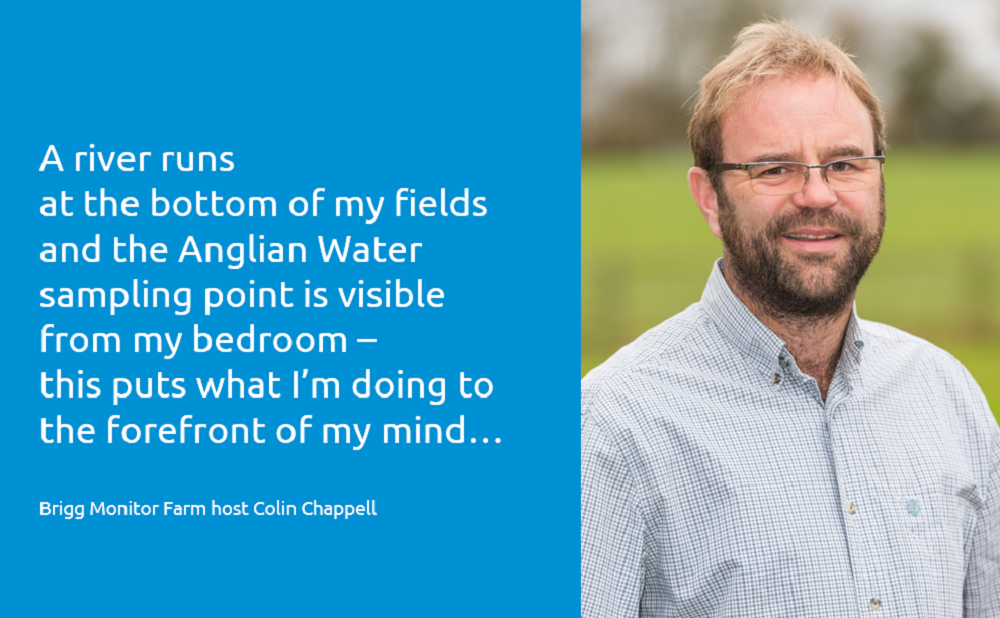Farming next to a watercourse used to extract drinking water
Thursday, 25 March 2021
Farming next to a watercourse used for potable supplies focuses the mind of Brigg Monitor Farm host Colin Chappell. From rotation and cultivation to crop protection, he takes stock of all available information before taking final decisions. This blog explores the integrated approach taken by this Lincolnshire farmer.
Find out more about Brigg Monitor Farm
Visit our integrated pest management page
A river runs at the bottom of my fields and the Anglian Water sampling point is visible from my bedroom – this puts what I’m doing to the forefront of my mind. So how does this influence my decisions?
Preventing issues using cropping and cultivations
Firstly, I look to my soils and cropping choices. I have a few fields that I can direct-drill with no issues, but other fields need some shallow cultivation. When I cultivate, I will plant as I go to stabilise the soil as I loosen it to help reduce run-off. I have a rule of six weeks – if the land is going to be bare for longer than that, I make sure I plant a cash crop or a cover crop.
Where possible, I choose a cash crop that minimises the need to terminate a cover crop and the allopathic effects that may come with it. However, I will always put a cover crop into the ground, where it’s needed. They feature regularly in the rotation.
Is the weed a problem?
Having a strong plant is important, so I have brought the drilling date forward for many spring crops to establish the plant before pest or weed pressures are too substantial.
Last year, I drilled beans early with a pre-emergence herbicide to help get them away and outcompete weeds. However, having included buckwheat in my cover crop mix to scavenge phosphate, I then found it growing with the beans. I had two options – spray it or leave it.
Where possible, I try to avoid the use of bentazone herbicides, because bentazone is highly water-soluble and can contaminate water for a long time. The beans were growing next to the river and, although the weather was warm and dry, the risk of a torrential thunderstorm pushing the chemical into the water wasn’t one I was willing to take. So I decided to let the buckwheat grow and not apply any more herbicides.
The buckwheat didn’t respond to glyphosate quickly, which made combining the beans more difficult. However, the approach was cost-effective in the end (due to reduced herbicide costs).
Only apply what is needed, when it’s needed
I always assess the need for crop treatments before doing anything, taking into consideration crop health, cost–benefit and the risk of pollution.
Legislation on the use of metazachlor exists to reduce contamination in water, so I have stopped using it. If I am drilling in a particularly weedy field, I consider Clearfield technology, instead. However, I often wait and assess the weed profile before taking action.
As for many other farmers, oilseed rape hasn’t consistently yielded, so I didn’t want to spend a lot on crop protection (if the crop wasn’t going to cover the cost). Therefore, last year, I drilled the crop in July, behind the forage barley, and didn’t put on any insecticides, herbicides or fungicides.
By November, it was as high as my knees, so I chopped it down with a flail mower to control cabbage stem flea beetle (CSFB). We left a bit uncut, which showed that cutting reduced pest pressure by tens of thousands.
I still haven’t applied any fungicides or insecticides and the crop is looking good – it will be interesting to see what it yields.
Considering product choice
Metaldehyde has been on the radar for water companies for years. It only takes a small amount in a large volume of water to contaminate it.
The water that goes past my farm runs into a 15-acre reservoir. Even though it is a large body of water, it doesn’t take many pellets to contaminate it, resulting in it needing to be emptied and recharged.
We tried to prolong metaldehyde by not treating the headlands, as they’re rolled a lot more. However, when moving from field to field, we cross a bridge and it couldn’t be guaranteed that a slug pellet wouldn’t accidentally fall into the water. For this reason, about three years ago, I swapped metaldehyde for ferric phosphate to control the slugs. It has worked better for us without increasing cost.
Looking forward
Farming evolves – we face new challenges and find new ways to do things, each year. I have a good relationship with our Catchment Sensitive Farming Officer, who will advise anyone in the local area of any potential issues with water quality. The issues are flagged before they become a problem. Being forward-looking means that we can take precautions and plan a range of management interventions in advance – like rotation, product choice, timing decisions and collaborating with others.
To try to reduce reliance on glyphosate, I am considering working with a local sheep farmer to use the sheep to graze cover crops, instead. If there is ever an issue with the use of glyphosate, I’d like to have a tested alternative strategy in place. I also try to reduce the amount of insecticides I use, as I don’t want to kill off any of the beneficials – I want to leave them to do their job for me!
What I’ve learnt works best for me
- Use the information available to make informed decisions. For example, I use my weather station to provide local weather data to direct crop management
- Look at the crop, its surroundings and the weather before deciding when to take action. For example, I’ve moved away from feeling I need to do T1 by a certain date. If there is unlikely to be a return on chemicals, I don’t apply them


